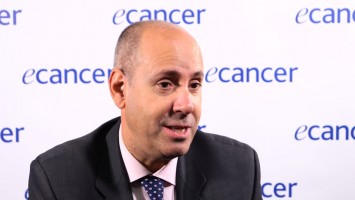ASCO 2013
Lapatinib in combination with chemotherapy in breast cancer
Dr J. Randolph Hecht - UCLA Medical Center, Santa Monica, USA
It was a collaboration between our non-profit academic international group which is called TRIO, or Translational Research In Oncology, and GSK. What it looked at was adding lapatinib, which is a small molecule tyrosine kinase inhibitor of EGFR and HER2, that’s already approved in breast cancer and looking at it in combination with chemotherapy.
The methods were a fairly standard large randomised phase III trial. The most important thing is that we had a very homogenous group of patients in that they all had to have HER2 that was FSH amplified by a central laboratory rather than… because there’s a lot of heterogeneity between labs around the world. So I think we have a really, truly biologically driven group. It’s an international trial in 22 countries around the world: Asia, Europe and, to a lesser extent, North America. A total of 545 patients were randomised, of those not all of them had centrally documented HER2 positivity. This was an adventure of an analysis, what I reported were 350 events and what it showed was that overall there was no statistically significant improvement in overall survival by adding lapatinib to a standard capecitabine and oxaliplatin based regimen. The things that were particularly interesting were there did seem to be improvement in response rate, there did seem to be an improvement in progression free survival, there seemed to be an improvement in duration of response but there was no significant improvement in overall survival.
There were certain pre-planned subgroups where we looked at where patients came from. About 40% of patients came from Asia and in that group the hazard ratio was 0.68, so a major improvement, basically a 32% improvement in overall survival in that very large subgroup. Once you got outside of Asia no significant improvement, definitely with a hazard ratio of greater than 1.0. If you looked at patients who were under 60, which was a little less than half the patients, very similar – a hazard ratio of 0.69, so a 31% improvement in overall survival; patients 60 years of age or older, no difference. We have a lot of biomarker analysis that is underway; we have a separate translational team, we have a separate translational committee that’s looking at these and I think they’ll help try to understand why these surprising differences.
Do you have any theories at the moment?
There are a lot of theories that I think we were able to disprove. One thought was that it appears that Asians are better able to tolerate fluoropyrimidine so one of the questions would be that maybe it had something to do with the Asians were better able to tolerate the chemotherapy and that had something to do with it. But actually there were no differences when we looked. So we know there are biological differences between tumours in Asia and in the rest of the world, that has been known for a long time. Patients after surgery who are operated on, particularly in Korea, for example, and to a lesser extent in China, do better than in Western countries so there are biological differences. They tend to be younger so there may be an overlap with the difference less than 60 versus greater than 60 but I think there’s a huge amount of biomarker work and biology work that really remains to be done.








